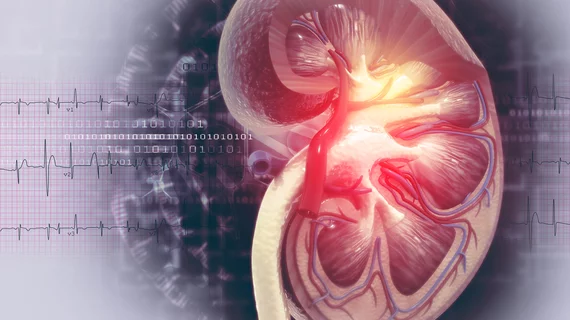Risk model helps radiologists predict whether patients will experience contrast-associated injury after CT
Experts at Brigham and Women’s Hospital have developed a risk model that helps radiologists and other specialists predict whether patients may experience contrast-associated kidney injury after a CT scan.
Cancer patients frequently undergo such exams using agents that contain iodine. However, they may be uniquely predisposed to kidney injuries stemming from these contrast materials, researchers detailed in the American Journal of Roentgenology [1].
Scientists set out to better understand this phenomenon, using data from more than 25,000 adults who underwent nearly 46,600 contrast-enhanced CT scans. Associated kidney injury occurred in about 5.8% of instances, they found, while the strongest predictors of these occurrences included stage 4 or 5 chronic kidney disease or low-serum albumin levels.
“We developed and validated a risk score using readily available clinical data to predict the likelihood of [contrast-associated acute kidney injury] in patients with cancer undergoing contrast-enhanced CT,” Shruti Gupta, MD, a nephrologist with Brigham and Women’s, and co-authors concluded. “This model will enable radiologists, oncologists, nephrologists, and other practitioners to identify those patients who are at highest risk for CA-AKI, and thereby facilitate appropriate implementation of preventive measures.”
The team retrospectively gathered their data from three academic medical centers who delivered the scans between 2016-2020. They also recorded other factors such as demographic data, malignancy type, medication use and comorbidities. Other risk factors for kidney injury included hematologic malignancy, diuretic use, diabetes mellitus, heart failure and higher contrast media volume.
Gupta and co-authors developed a risk score ranging from 0-53 using all of these factors. Stage 4 or 5 chronic kidney disease carried the greatest point value at 13, for example, and risk of injury increased with higher scores. Among those with the lowest risk total, tallying a score of 4 or lower, there was a 2.2% danger of contrast-associated kidney injury. Meanwhile, those with a score of 30 or higher experienced injury about 32.7% of the time.
“The risk score overall showed good calibration and discrimination,” the authors noted. “To our knowledge, this study is the largest and most comprehensive investigation to date of [contrast-associated acute kidney injury] in patients with cancer.”
Read more from AJR below.

